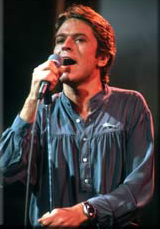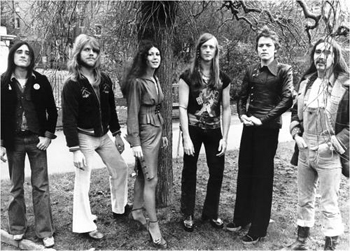You may have noticed that updates from Bootleg City have been erratic the past few weeks. Well, it’s all the mayor’s fault. It seems he’s decided to be selfish and work on his advanced education. I’m sure Matt Wardlaw and the rest of the local opposition party will be all over this, saying our mayor should’ve had that advanced degree before he asked us to vote for him in the first place.
But you know what? I don’t care. I am so far above this petty nonsense. (Seriously — I live on a ridge looking down on Bootleg City. As long as what happens down there doesn’t affect me up here, I’m game.)
On the other hand, I’ve had the self-appointed title of Minister of Fast Food and Entertainment in this town for a while now, so I feel I need to provide some of the latter while the mayor gets his shit together. (What, you think I should wait for Wardlaw to step in? Fuhgeddaboudit.)
 So, I’ve used my powers as MFFA to bring back the coolest dude ever to appear on our planet: the late Robert Palmer. And this ain’t the MTV-era Robert Palmer with the suit and tie that most of you youngsters remember. By the fall of 1980 he’d established himself as a minor star in America, but he obviously wasn’t interested in being pigeonholed into any particular musical genre: He did rock. He did reggae. He basically used Little Feat as a backing band. He even recorded a ballad or two. And he came up with a few hits.
So, I’ve used my powers as MFFA to bring back the coolest dude ever to appear on our planet: the late Robert Palmer. And this ain’t the MTV-era Robert Palmer with the suit and tie that most of you youngsters remember. By the fall of 1980 he’d established himself as a minor star in America, but he obviously wasn’t interested in being pigeonholed into any particular musical genre: He did rock. He did reggae. He basically used Little Feat as a backing band. He even recorded a ballad or two. And he came up with a few hits.
After three solo albums of hit-or-miss music Palmer moved to the Bahamas, and by 1978 was making albums with a ”Caribbean-style” influence at the world-famous Compass Point Studios, conveniently started by his record label, Island. This seemed to work: ”Every Kinda People” became his first bona fide hit in the U.S. The next year he did a rock album, and ”Bad Case of Loving You (Doctor, Doctor)” became his mack daddy. By 1980 Palmer teetered on the edge of stardom.
And so he toured some more, sang wherever he was accepted. He had a band that could kick ass live. And he still teetered. But by that point I’m guessing he didn’t care.
This week’s featured boot, from a performance at the Painters Mill Music Fair in Owings Mills, Maryland, on September 29, 1980, was originally broadcast on The Source Radio, one of the many ”network” live shows that appeared across the FM landscape in the late ’70s and early ’80s (The King Biscuit Flower Hour is one you’ve probably heard of).
You might be surprised to discover that a lot of the concerts played on these shows were recorded, mixed, and distributed on vinyl, including this 1980 Palmer gig. The recording has a slight surface static and an occasional pop (but no skips!), which help bring out the nostalgia — if you’re old enough to have any, that is.
Maybe somebody out there who worked in radio at the time can tell me why vinyl was used to distribute these types of affiliate radio shows. They seem like they’d be expensive to manufacture and ship, but everybody did it. Hell, I even have a few of Casey Kasem’s American Top 40 shows on vinyl, which I picked up in the mid-’80s. My guess is, no matter how small the station in those days, you knew they had a turntable; they might not have a cassette player or a cart machine, but everybody had a turntable in the studio.
Just my theory, though. If you have an explanation, I’d love to hear it. But back to this show …
Palmer and his band — Alan Mansfield on guitar, Jack Waldman on keyboards, Chris Bishop on bass, Michael Dawe on drums — put together a pretty nice set of selections from all of his solo albums up to that point. Included are his two major hits (”Here’s a song you know,” he says, before ”Every Kinda People”) along with all the assorted types of music he’d experimented with over the previous six years. Unfortunately, some of these songs were originally recorded after Palmer was introduced to Gary Numan.
I have one word for that: plastic. And although the then-new single ”Looking for Clues” wasn’t written with Numan, it was obviously influenced by him. Within a year of this Maryland show, the video for such a terrible song would be a staple on the new cable channel known as MTV.
It was a groundbreaking video, though, and led to familiar images of several bouncing boobs lip-synching a song.
Suits. Ties. Iconic images of the ’80s. But they proved MTV would overtake the necessity of a performer having to perform in front of people. Palmer’s band putting forth a live version of ”Looking for Clues” a year before MTV debuted, it could be argued, was a tipping point, after which live music didn’t matter so much anymore.
About a week or so after the Painters Mill show he was in London recording Maybe It’s Live. Included on this mostly live album were several studio selections, including ”Style Kills,” a song cowritten by none other than Gary Numan. I have to give Palmer credit: he closed this particular show with a song nobody’d heard of, from an album that wouldn’t be released for another year. Robert Palmer never paid attention to what was cool — and that’s what made him cool.
You’re Gonna Get What’s Coming
Not a Second Time
Sneakin’ Sally Through the Alley
I Dream of Wires
What Do You Care
What’s It Take?
Every Kinda People
What Can You Bring Me
Under Suspicion
Man Smart (Woman Smarter)
Looking for Clues
Johnny and Mary
Sulky Girl
Jealous
Bad Case of Loving You (Doctor, Doctor)
Pressure Drop
Style Kills
 Since I’m known in these parts as the friendliest dude around who takes this shit seriously, I have a bonus for you: a BBC In Concert show featuring Vinegar Joe, one of Palmer’s early bands.
Since I’m known in these parts as the friendliest dude around who takes this shit seriously, I have a bonus for you: a BBC In Concert show featuring Vinegar Joe, one of Palmer’s early bands.
It was recorded sometime in 1973, the exact date of performance and/or broadcast having been lost in the mists of time. Palmer was the rhythm guitarist for the band, and was also credited as ”co-lead singer.” But the true lead vocalist of Vinegar Joe was the awesome Elkie Brooks, who’s had a pretty steady solo career herself in Europe the past 30 years. Coupled with Palmer’s countervocals and the tightness of the rest of the band, she nails this performance. (You can correctly assume Vinegar Joe never got the break they deserved.)
We also find out during this concert that there was a second groupie in Little Rock, Arkansas, who had a song written about her. Everybody knows the story of ”Sweet, Sweet Connie,” but here Brooks presents the story of Irene and her ”very, very beautiful breasts.”
Hey, it was the ’70s.
Let Me Down Easy
Food for Thought
Talkin’ ‘Bout My Baby
[band introductions]
Giving Yourself Away
[interlude]
Black Smoke (Rising From the Calumet)
Proud to Be (A Honky Woman)




Comments